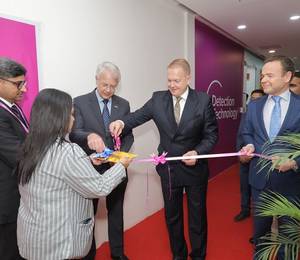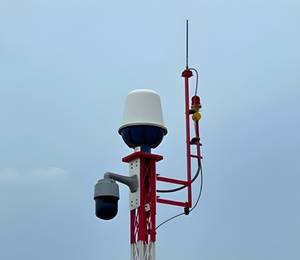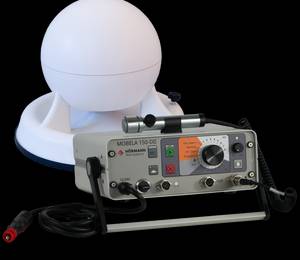Cleveland, Ohio wanted to strengthen its efforts to prevent crime and enhance citizen and infrastructure security throughout the city. The city of Cleveland is officially home to about a half million residents and its population swells to about 750,000 on workdays, and around a million on certain weekends. The city is the business, entertainment, healthcare, education and sports hub for Cuyahoga County and Northern Ohio. To increase protection of critical infrastructure and institutions, the city worked with the Department of Homeland Security to help fund a high-speed wireless video network with a dual purpose: to guard against national security threats and to help prevent crime and provide enhanced citizen safety.
Video Surveillance Network to Monitor and Protect
The city deployed a pilot program using a Motorola Solutions wireless mesh video surveillance network to monitor and protect the downtown area. The Cleveland Department of Public Safety has always been committed to being on the leading edge of technology and a few years ago created the Cleveland Shared Security Surveillance (CS3) program. The goal of the program is to provide officers and first responders with a shared security presence and enhanced officer awareness through a high-speed wireless mesh network with video surveillance cameras. As the city’s first initiative, a pilot video surveillance system of nine cameras were positioned around the Public Square area in the heart of downtown Cleveland which then expanded to the CS3 initiative.
The successful pilot program has resulted in the ongoing expansion of video security throughout the city. From the initial Public Square pilot, Cleveland’s wireless video surveillance network has continued to evolve and grow. With funding through Homeland Security and other federal organizations, the city and Motorola Solutions have deployed a continually expanding network throughout the city. Today, the city itself has 25 cameras and a growing number of cameras provided by local organizations and businesses that are tying into the network.
Coverage is expanding to the port area, the west side market and the arena district, and soon, the network will be extended deeper into the neighbourhoods around the city. With the cameras in place and clearly visible, the system enables citizens and visitors alike to feel a greater sense of safety and security.
Increasing Officer Awareness with Help of Video Security
The St. Patrick’s Day Parade is one of the city of Cleveland’s most popular annual events. More than half a million people come downtown to join the party, making security a significant challenge. “To monitor activities and provide security for all those folks is very difficult, especially on foot,” says Mike McGrath, Cleveland’s Chief of Police. “That’s where video surveillance comes in. The cameras allow officers to monitor activities in real time so they can quickly identify potential threats and respond faster and better.”
Security Cameras Stream Real-Time Information to Police
The city’s video surveillance planning began a few years ago with the creation of the Cleveland Shared Security (CS3) program. The CS3 program is a public-private partnership that allows security cameras to stream real-time information back to a police command vehicle, Emergency Operations Centre (EOC) and to a dispatch centre. Cleveland’s cameras can tilt, pan and zoom in on a particular area to follow the activities of an ongoing situation or help predict a dangerous situation before it happens. Square one for the program was a nine-camera pilot deployment around the downtown Public Square area which has proven to be highly successful.
Motorola Solutions’ Integration Services played a key role in the City of Cleveland’s video surveillance project, resulting in an excellent model for planning future video solutions. Starting with a small build out of a wireless network system, the project has evolved into a phased in approach of an ever-growing system with increased capability and functionality including the CS3 public private partnership.
Better Situational Awareness for First Responders
“The day-to-day value the camera system delivers is two-fold,” says Larry Jones II, CS3 Project manager. “There’s better situational awareness for first responders and that leads to increased safety—and a heightened sense of security—for our citizens and visitors.” The city is incorporating some of the cameras into its CAD (Computer Aided Dispatch) system. “We want to focus on getting our video into the dispatch centre where it can help police, fire and EMS as they arrive on a scene,” continues Jones II. “We want a dispatcher to be able to say, ‘those guys just ran to the west, one’s in blue, the other’s in red.’” Video solutions also allow an emergency responder in distress to press an emergency button on his or her radio that triggers an alarm at the dispatch centre. The Video Solutions system then identifies neighbouring cameras and directs them to the responder’s coordinates.
A Network Growth Spurt
Not surprisingly, the Video Solutions system is growing quickly. “The system has been successful from a number of perspectives,” says Martin Flask, director of Public Safety. “As a result, community groups and elected council people want us to expand surveillance throughout all the neighbourhoods of the city of Cleveland.”
The city is expanding coverage to its port area, the west side market and along the lakefront where facilities such as the Rock ‘n Roll Hall of Fame, Browns Stadium and Jacobs Field are located. In addition to extending the network geographically, the city and a number of other public and private organizations are also expanding by adding cameras. “One of the great things about having an infrastructure in place,” adds Jones II, “is that as private entities add cameras of their own, we can tie those cameras into the system.” As the number of cameras grows, the surveillance network is increasingly being used to not only discourage crimes, but to help solve them. Explains Flask, “It’s also provided important forensic evidence that helps our police to solve some crimes that would not potentially have been solvable had the surveillance system not been there.”
Mobile Video Security for Areas without Video Cameras
Cleveland also has the capability of providing video security in areas that don’t yet have video cameras deployed. “If we don’t have coverage in an area, we would deploy our command bus,” says Quenton Cantionez, Public Safety Systems Manager. “We have cameras on the command bus, including one on the boom, as well as portable cameras on tripods. We deploy the unit to a location, and we can provide live monitoring and, with point-to-point line-of-sight connectivity, send a video feed to one of our towers.” If there’s no line of sight connectivity, personnel can record video on the bus for evidentiary purposes. Video can also be sent to the city’s Emergency Operations Centre in emergency situations.
Force Multiplier
The Video Solutions network also acts as a force multiplier. “In today’s culture where we have this flash mob mentality,” says Chief McGrath, “for us to be able to use the video feed to observe these people in downtown Cleveland, and then relay that intelligence information to the officers on the street, is very, very important. Video security has definitely supplemented our workforce.” Adds Cantionez, “The overall benefit of having the video security network is to have eyes in places when you don’t have eyes available.”
Motorola Solutions’ Video Solutions system allows first responders to view live, real-time, 24/7 visuals of their communities. They have immediate access to view commercial districts, neighbourhoods, high-risk areas, crowded public events, dangerous intersections, public transit vehicles, and municipal buildings when they’re not physically on the scene. Live mobile video streaming from the scene back to the command center or eventually to hand-held devices – such as Motorola Solutions’ LEX L11– enhances coordination of efforts from all officers and response teams.
An Ounce of Prevention
“The most important aspect of the camera system, for me personally, is the preventive component,” says Chief McGrath. The city feels strongly that simply the visible presence of the cameras is a safety benefit. Cameras are mounted in plain sight on fixed utility poles and other structures. The city wants residents, visitors and especially those who come into town with another agenda to know that they’re there. “We have blue strobe lights on the top of them,” McGrath continues. “So when you’re walking through our downtown neighbourhood, especially at night-time, you’ll see these blue strobe lights all over the place. That’s a blanket of security I don’t think you can put a price tag on.”
Partnerships and Funding
The city of Cleveland was able to obtain funding for the Video Solutions project through a variety of grants. “As part of our grant application, we identified critical infrastructure here in the city that could be targets of some type of national threat,” explains Chief McGrath. Funding from the Department of Homeland Security and other federal organizations has allowed for CS3 to support 25 city owned cameras and dozens of other cameras owned by local organizations, businesses and other public safety agencies. The result is a partnership in which national and local security programs converge and overlap, and the city has been able to use its federal funding to maximum advantage.
In mission critical public safety networks, vendor partnership is all-important. The working relationship between the city of Cleveland and Motorola Solutions has been ongoing and successful both in terms of technology and equipment and of service. “Overall, Motorola Solutions’ responsiveness has been excellent, in my opinion,” says Cantionez. “They’ve been there for the design phase, implementation, go live, and troubleshooting. Motorola Solutions has been like our crutch, in a sense.” Others on the team agree. “Our partnership with Motorola Solutions has been very good, especially during implementation,” says Chief McGrath. “Any request we had, they responded to. If something wasn’t working, they were up on their ladders making it right for us. Vendor partnership and service are very important, especially in law enforcement.”
Positive Feedback
Citizen and business reaction to the Video Solutions system has been very positive. Cleveland’s Video Solutions system is protecting both property and lives relative to any national homeland security threat, and at the same time is helping the community reduce crime and increase safety.














